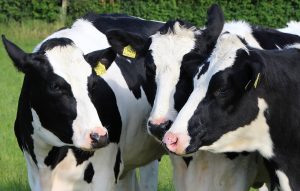While fluid (beverage) milk sales continue to run below year ago levels butter and cheese sales have shown some growth. But higher butter and cheese prices appear to be slowing down butter and cheese sales. With inflation, restaurant traffic is down hurting both butter and cheese sales some.
Dairy exports continue to perform well, supporting milk prices. The volume of July exports on a milk solids equivalent basis was up 5% from a year ago. While nonfat dry milk/skim milk powder exports were 10% below a year ago, whey exports were 13% higher, lactose exports 22% higher, butterfat export 63% higher and cheese exports continue to expand being 2% higher.
Milk prices weakened
With these market fundamentals, milk prices will continue to show some weakness in September. The Class III price had peaked at $25.21 in May and had fallen by about $5 to $20.10 in August. September prices could fall below $20.
Cheese prices were quite volatile in August. The price of 40-pound cheddar blocks during August ranged from $1.7150 per pound to $1.89. Cheddar barrels ranged from $1.7950 per pound to $1.9475. Dry whey ranged from $0.4350 per pound to $0.48.
But cheese prices have shown real strength in September. The month started with 40-pound cheddar blocks at $1.7350 to now at $2.0525 and cheddar barrels from $1.85 to now $2.1025. With this strength the Class III price could return to $21 or higher for the last quarter of the year.
The Class IV price peaked at $25.83 in June and fell by about $1 to $24.81 in August. The September Class IV price should be about $24.70. Butter reached $3.02 per pound on August 22 and set new records in September reaching $3.24 on September 13 and is now $3.1525.
Grocery stores have been building their stocks of butter to meet the expected strong holiday sales. Once stock levels are built we can expect butter prices to weaken some by November going into December. Nonfat dry milk started September at $1.52 per pound, reached $1.5875 and is now $1.56. The Class IV price Class IV price could fall below $24 by November.
Long range price forecast uncertain
It has been difficult making long range milk price forecasts. Looking into 2023 is no easier. The level of milk production, domestic demand and dairy exports are all subject to change.
At this time, it appears milk prices will average lower in 2023 than this year but remain relatively strong. With little increase in 2022 milk production, we can expect some recovery in milk production in 2023 but probably no more than around 1%.
Higher milk prices usually spur increased milk production. But dairy producers are facing much higher feed and other input costs, shortage of labor and fewer available dairy replacements.
The average size of the dairy herd may increase slightly and milk per cow may improve to about 1% meaning an increase in milk production around 1%. This level of milk production will be supportive of milk prices.
Domestic demand may soften some with slowing of the economy and yet rather high inflation. Dairy exports continue to look positive. Milk production in major dairy exporters like the EU, New Zealand and Australia continues to struggle from high feed prices, weather related issues and environmental regulations.
USDA forecast
USDA is forecasting an average Class III price of $19.70 down from an estimated $21.65 for 2022. The Class IV price is forecasted to average $20.85 down from an estimated $24.45 for 2022.
Current Class III futures are optimistic. Class III is fairly flat in the $20’s all year which is probably not realistic. Class IV futures start the year in the $22’s and falls below $20 at the end of the year. No doubt there will be some volatility in 2023 milk prices. At this time, it seems the Class III price could average between $1 and $2 lower than 2022 and the Class IV price could average $3 or so lower.


























